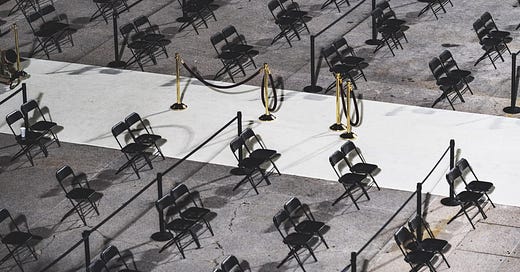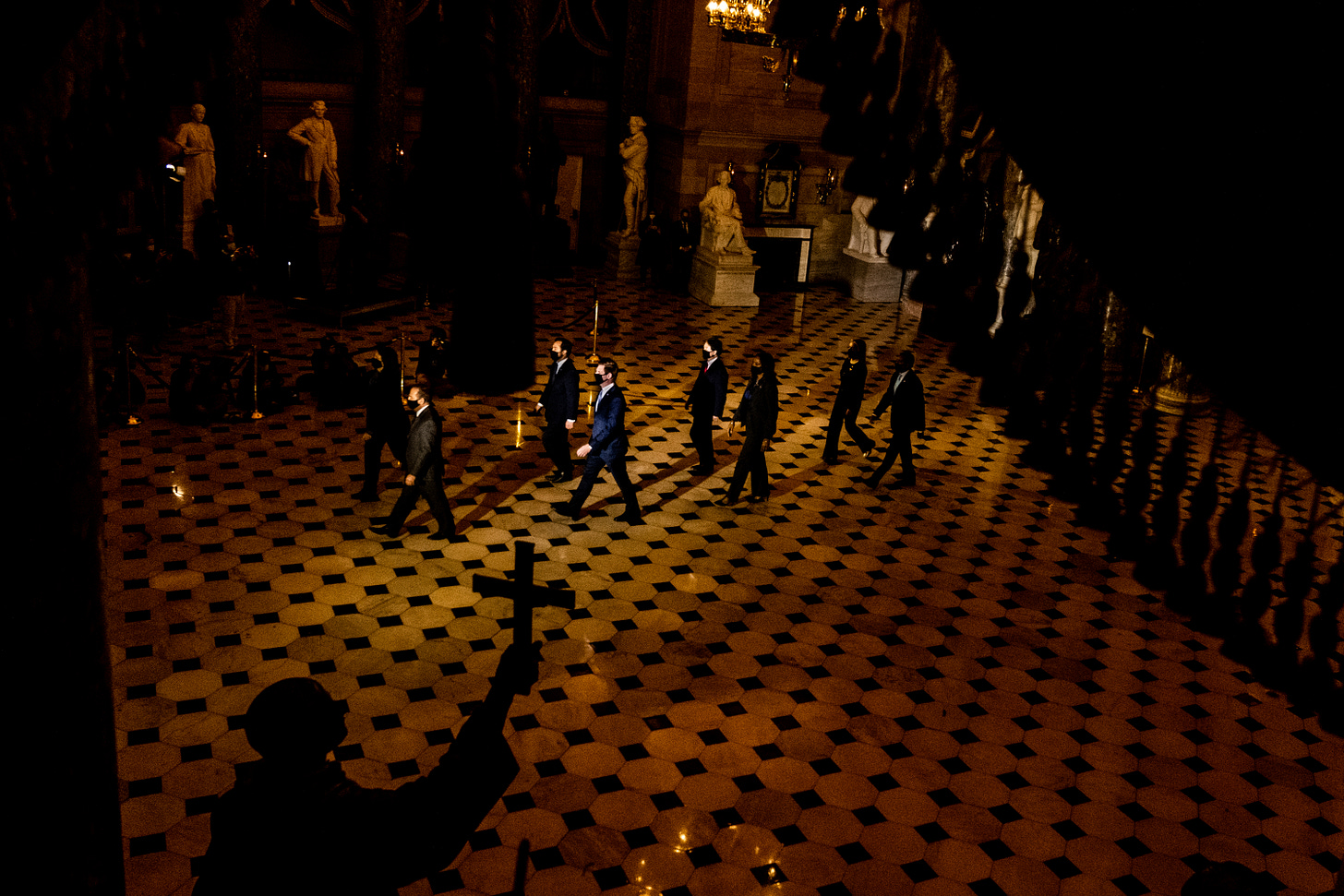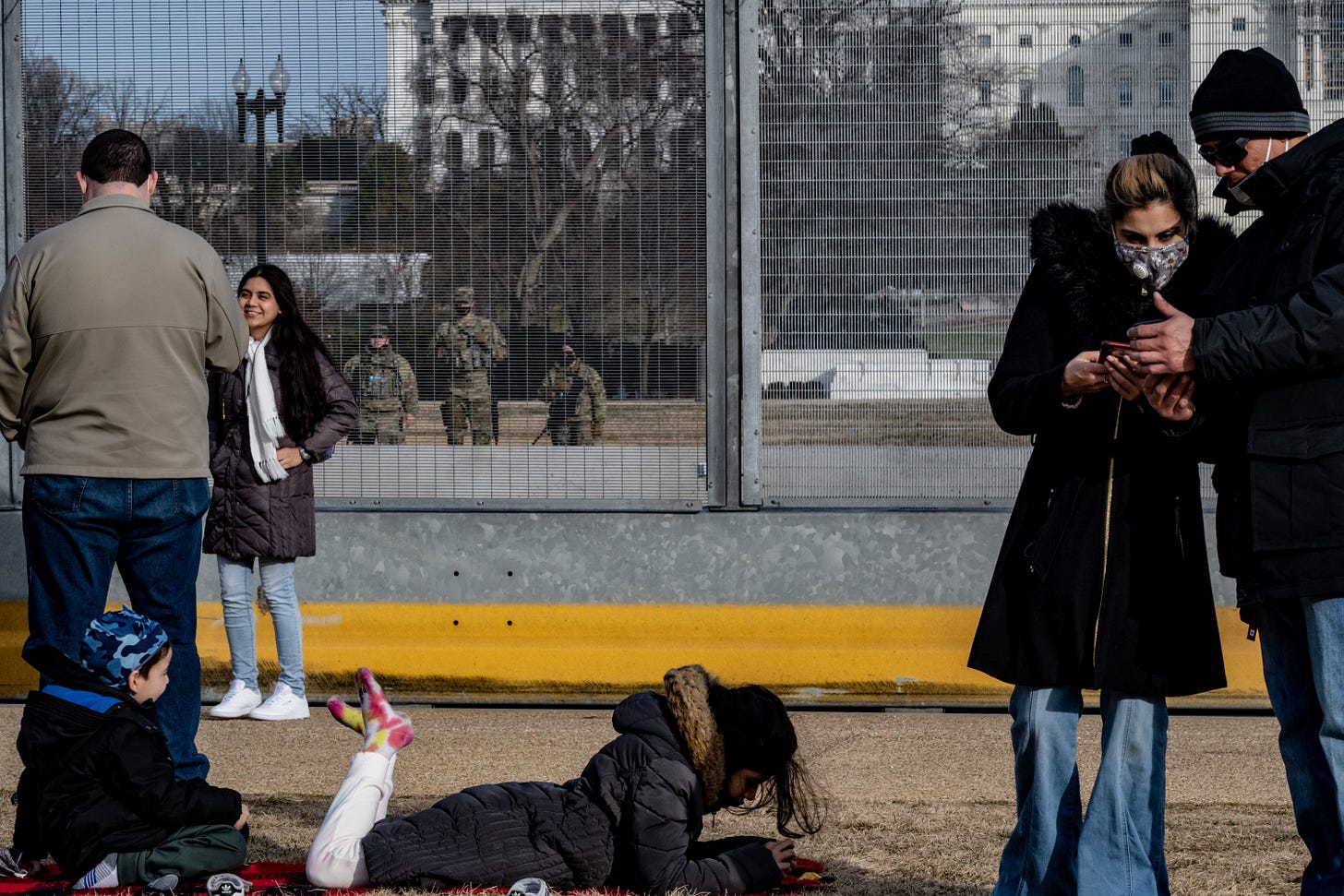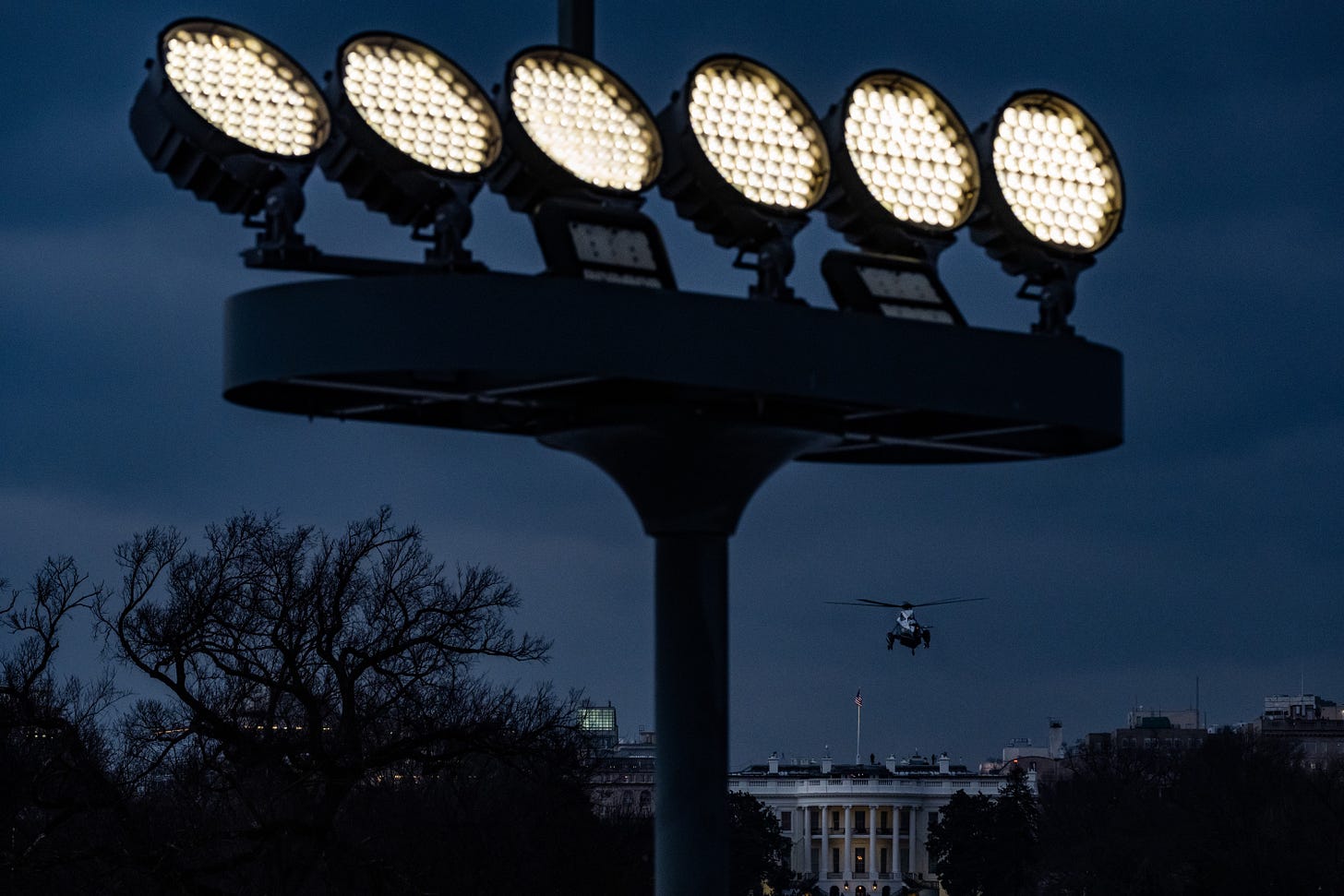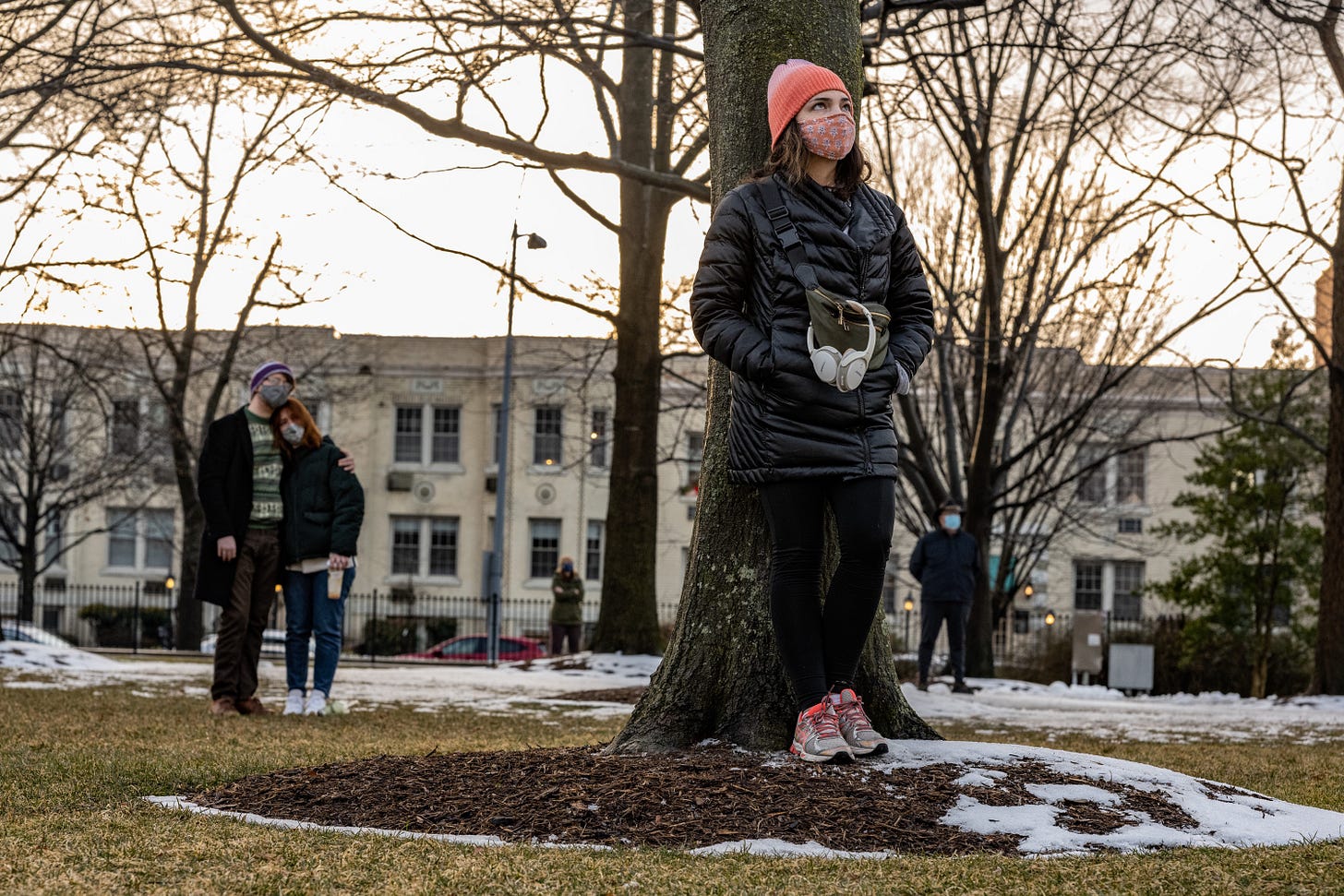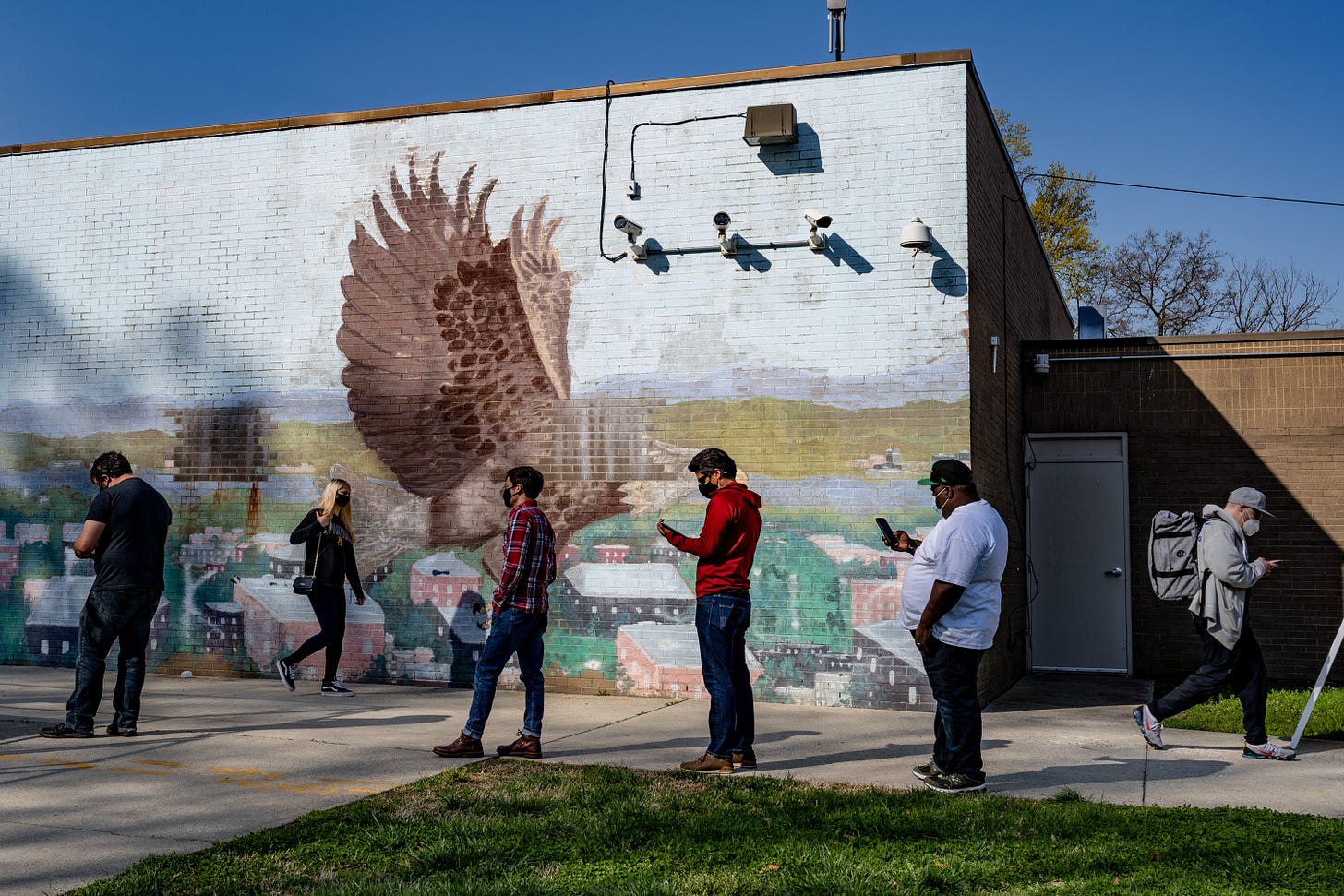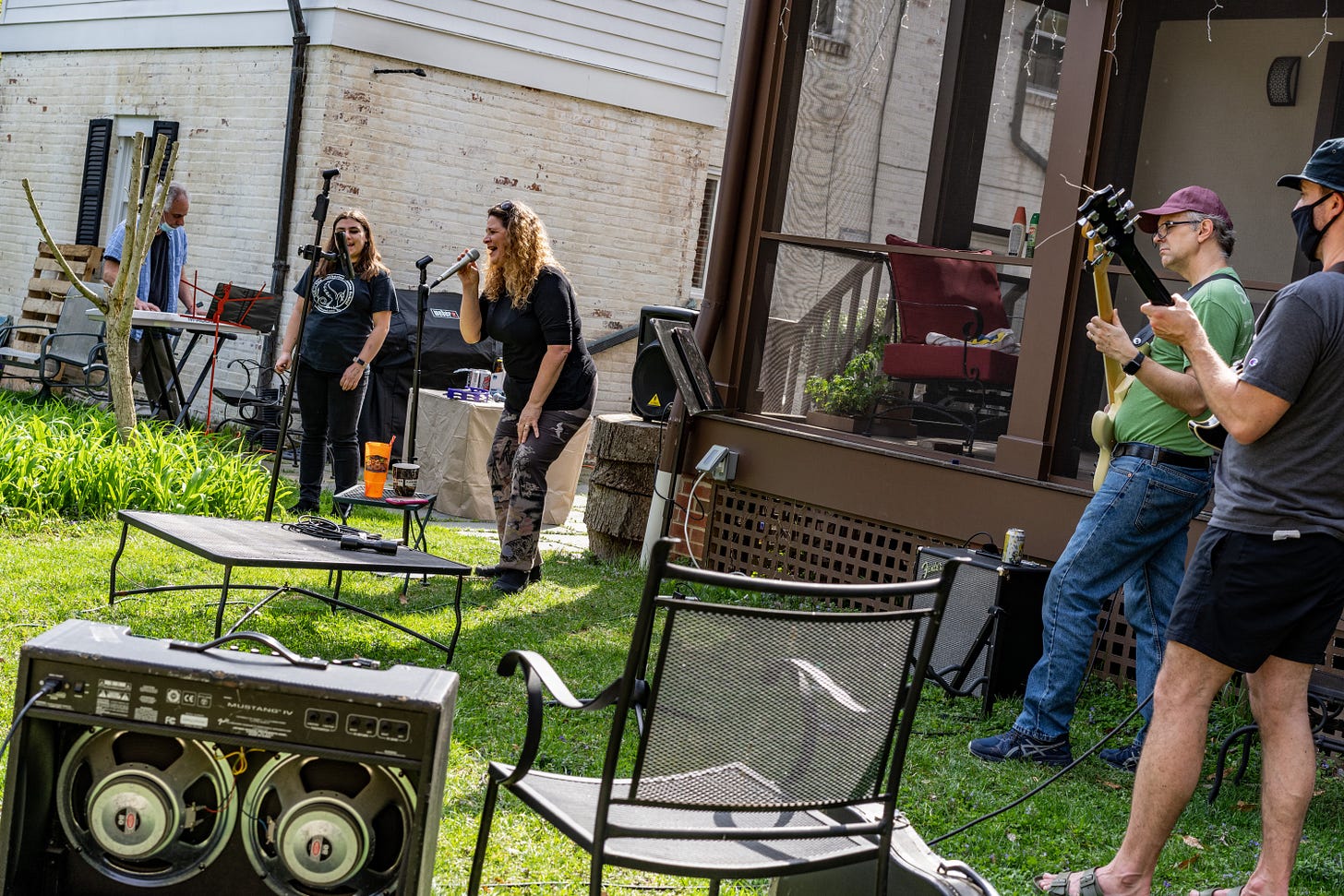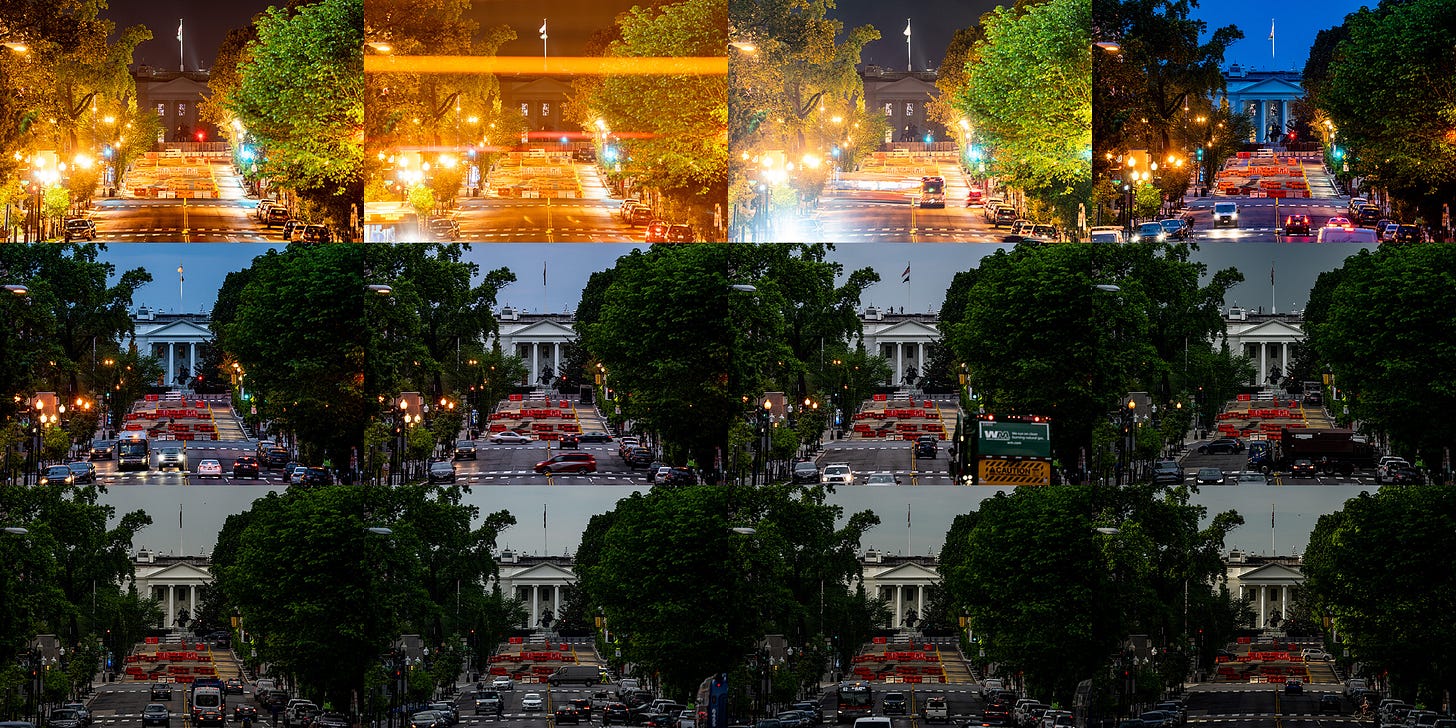Greetings kind Light Reading readers, happy to have you along. If you signed up for this and don’t know who I am, my name’s Stephen Voss and I’m a photographer living in Washington, DC. I photograph politicians for magazines, and, occasionally, bonsai trees. You can see my work on my website, and Instagram.
It was pitch dark and the rain was coming in sideways. A television reporter pulled a clear plastic bag over the top half of her body, trying to keep the “on-air” part of herself dry. I was standing on the Inaugural blue carpet looking down at a piece of white tape with “JRB” written on it in all caps, marking the spot where Senator Joseph Robinette Biden would raise his right hand and take the oath of office in a few hours.
I’d arrived to the Capitol that morning around 5AM, having navigated the ever-evolving maze of metal barricades that blocked off huge swaths of downtown DC. In the Dirksen Senate Office building, I walked quietly past dozens of National Guardsmen sleeping on the floor of a coffee shop.
The roar of a Presidential Inauguration crowd tends to build from the back, like a crowd doing the wave sonically. But this morning, it felt muted as a newly sworn-in President Joe Biden lowered his hand and gave First Lady Jill Biden a hug. Together they stood on the Inauguration stage at the US Capitol, on January 20, 2021.
Two weeks prior, I’d been on this same stage as tear gas clouded the air and violent insurrectionists broke through overwhelmed police lines to gain entrance to the Capitol. The dissonance between these two events was head-spinning.
The Inauguration was day one as I began a project to visually document the first 100 days of the Biden presidency and its rippling effects on Washington for Politico Magazine
Day.006 Footsteps and the dampened click of camera shutters break the silence in Statuary Hall as House impeachment managers walk the article of impeachment to the Senate side ahead of former President Trump’s trial. To one side, a statue of former Supreme Court Chief Justice Roger Taney sits, rendered in white marble. In June, the House voted to have the statue removed, citing the racist Dred Scott verdict which Justice Taney read from this very room.The structure of this project meant that each day was a new opportunity, a requirement really, to make a photo. I kept a running ideas list that I was constantly revising with the help of my photo editor at Politico. I closely watched a curated Twitter list to find out about spontaneous protests, gatherings and other opportunities.
Day.018 An unseasonably warm day brings crowds of people to the National Mall, a month to the day after the insurrection. Children wrestle on picnic blankets and gaze up at a pale, blue sky, just feet away from the looming metal and concrete barriers. People stop to take selfies by the fence, framing the photos to get the National Guardsmen in their photos. The soldiers stand still, looking back in silence. The combination of COVID restrictions and the National Guard deployment brought an astonishing quietness to downtown. Some nights, I’d walk several city blocks without seeing another person. For most of February, a permit dated January 6th for “First Amendment Activity” was taped to a lamp post on 14th Street.
Day.031 The winter light is fading quickly as I stand in wet grass on the National Mall, waiting. At last, I hear a distant thump-thump of the helicopters, then watch Marine One fly past the Washington Monument to land on the south lawn of the White House, ending President Biden’s first official trip since taking the oath of office. The barricades that blocked whole sections of the city seemed to be reconfigured weekly, making driving difficult. I began using the city bike share, riding down the middle of wide-open streets, a camera swinging from each shoulder.
Day.034 Scattered groups in twos and threes stand among the snow-ringed trees by the National Cathedral. The first bell tolls, then again and again, 500 in total to mark the 500,000th death of coronavirus in the United States. The glow of a setting sun alights the Cathedral's soaring limestone towers. The sound seems to hang in the air even as the bells go silent. Walking near the Capitol one night, I sensed movement in the dark shadows. A police car passed by and their headlights briefly illuminated a small, grassy park. Among the oak trees were dozens of National Guardsmen resting between shifts. They spoke quietly, cradling their weapons and using their camouflaged backpacks as pillows.
Day.078 I sit on a folding chair near the foul line of the basketball court in the recreation center. The nurse pushes her cart down the line and when it's my turn, I receive my Covid vaccine. Afterwards, we, the newly-vaccinated, sit in silence, waiting for a possible reaction. As I walk out, I photograph the line of people outside the recreation center with a fading mural of an eagle painted on it. It was hard to overstate the way the aftermath of January 6th loomed over the area around the Capitol. The fences, barbed wire and military presence brought a heaviness to the neighborhood, a symbol of an ongoing threat.
But, in other parts of the city, moments of abject normalcy occurred. People strolled under cherry trees, heavy with powdery pink blossoms. The sidewalk “streateries” were busy with diners eager to practice a return to a past life.
Day.081 A photo shared on Facebook brought me to a backyard in the city where neighbors gathered to play rock music together. There's no crowd listening and the music drifts down empty alleyways and rises up through the trees glimmering with the waxy green of early Spring.
Let 'em laugh while they can
Let 'em spin, let 'em scatter in the wind
I have been to the movies, I've seen how it ends
And the joke's on them
- Brandi Carlile, The JokeFor days, the specter of the final day of the project loomed. I needed a surefire photo, a scene that would both summarize and be worthy of my last day on this project. I decided instead of one photo, I would take (checks notes) 1,230.
Just like on day one, I got up well before dawn and loaded up a phalanx of gear. I drove down to Scott Circle, and set up a pair of tripods at the foot of a statue of Major General Friedrich Wilhelm von Steuben. The statue’s large marble base gave me the needed elevation to see down 16th street to the front of the White House. I would photograph two time lapses (one serving as a backup) as the sun rose. At 4:45AM, the cameras took the first photos.
Four hours later, the sun rose and light spread across the iconic white columns. I rushed home to process the images and build the time-lapse. I sent the final video to the amazing team at Politico that had been building out the site over the past months. That afternoon, the site went live.
This poem by Carl Sandburg (what a magnificent portrait that is by Edward Steichen) captures the feel of a nighttime DC, and, coincidentally enough, references a previous pandemic.
Potomac River Mist
by Carl SandburgAll the policemen, saloonkeepers and efficiency experts in Toledo
knew Bern Dailey; secretary ten years when Whitlock was mayor.
Pickpockets, yeggs, three card men, he knew them all and how they flit
from zone to zone, birds of wind and weather, singers, fighters,
scavengers.
The Washington monument pointed to a new moon for us
and a gang from over the river sang ragtime to a ukulele.
The river mist marched up and down the Potomac, we hunted
the fog-swept Lincoln Memorial, white as a blond woman's arm.We circled the city of Washington and came back home four o'clock in the
morning, passing a sign: House Where Abraham Lincoln Died, Admission 25
Cents.
I got a letter from him in Sweden and I sent him a postcard from Norway
… every newspaper from America ran news of “the flu.”
The path of a night fog swept up the river to the Lincoln Memorial
when I saw it again and alone at a winter's end, the marble in the mist
white as a blond woman's arm.
Currently
Phosphorescent BBC Sessions, “Song for Zula” I’ve loved this song since I heard it for the first time in 2013, but this newly-released stripped down version that songwriter Matthew Houck performed at BBC takes it to a new level.
Day 81 of my project for Politico includes a brief audio recording of the backyard band doing a fun rendering of Brandi Carlisle’s ‘The Joke”, a song that’s stuck around on various playlists as I’ve driven around the city looking for photos.
Rosencrans Baldwin, Everything Now: Lessons from the City-State of Los Angeles - Baldwin’s prose ripples off the page in this brilliantly inventive story of Los Angeles in all its concreted hellscape glory. The book attempts to frame LA as a city-state hybrid of Singapore and Venice, and leans into its history and the characters that define it -
“Los Angeles probably has no single unifying dream besides the straightforward desire to be loved or not die in an earthquake—or perhaps not feel so alone in the vastness of the immense slouching shapelessness—but if there is one narrative that outsiders pin to the city-state, stocked with clichés but also some essential truths, it is often the dream of Hollywood.
No matter what industry a citizen works in, the entertainment business often feels like an alien ship hovering over the county, spewing out chemtrails that breeze around the world. Film, television, music. Icons of celebrity culture and “reality programming,” including the Hollywood sign itself, erected in 1923 as a stunt to promote a real estate development. It was viewable from our block. Every day I watched tourists pose outside our house for a picture with the big abstraction—that embodiment of fame, stepping into the limelight, becoming “like the Hollywood sign itself, instantly recognizable,” as Leo Braudy put it in The Hollywood Sign.”
Take good care and thanks for reading along.
If you’ve made it this far and enjoyed the newsletter, I would greatly appreciate you sharing it by using the link below or posting someplace social.

